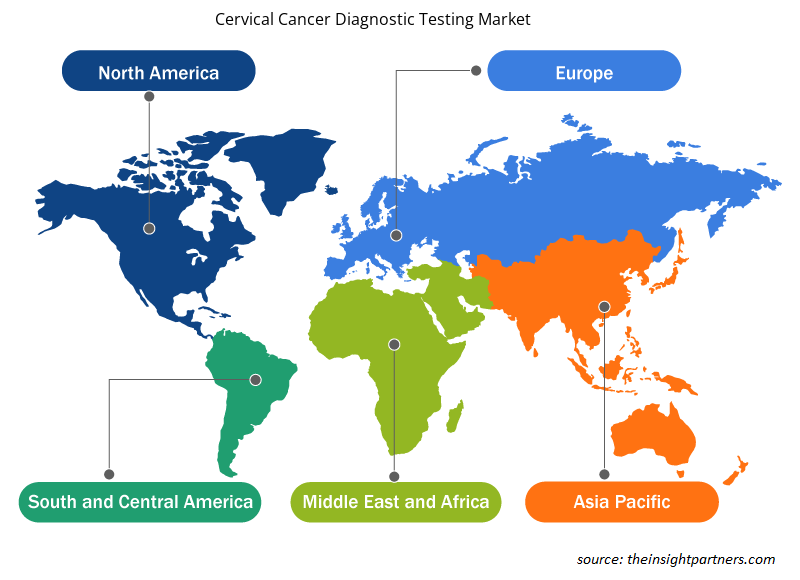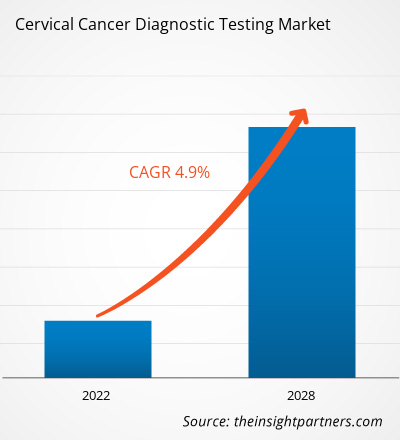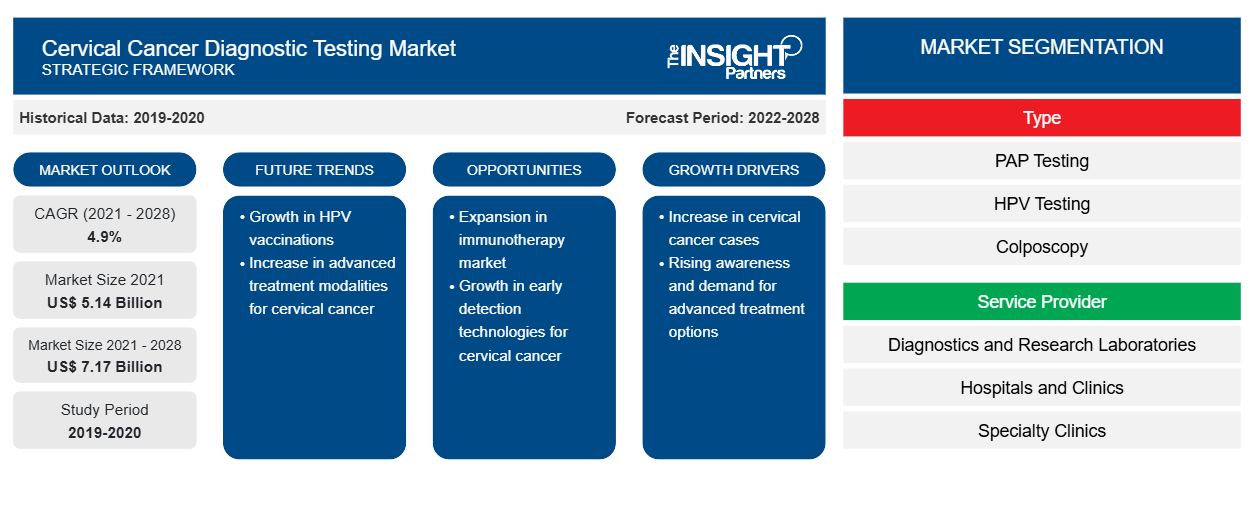Se proyecta que el mercado de pruebas de diagnóstico de cáncer de cuello uterino alcance los US$ 7.165,92 millones para 2028 desde los US$ 5.141,25 millones en 2021; se espera que crezca a una CAGR del 4,9% entre 2021 y 2028.
El cáncer de cuello uterino tiene una tasa de mortalidad significativa (casi el 50%), que se puede reducir con una detección y prevención tempranas. Las alteraciones precancerosas ofrecen oportunidades de prevención y tratamiento porque la progresión de la enfermedad suele retrasarse. Sin embargo, debido a la falta de conocimiento o acceso a servicios de diagnóstico, muchos casos se detectan en etapas más avanzadas de la progresión de la enfermedad. El virus del papiloma humano (VPH) es una causa primaria de cáncer de cuello uterino que generalmente se transmite por contacto sexual. Hay más de 100 cepas de VPH, y 13 de las cuales son de alto riesgo o cancerígenas. El gen activo - E6 o E7 - determina si una cepa de VPH es de alto o bajo riesgo. E6 se une a p53, causando destrucción proteolítica. E7, por otro lado, se une al retinoblastoma; la unión desplaza los factores de transcripción previamente unidos, lo que da como resultado que se detenga el ciclo celular y se inhiba la regulación de la apoptosis. La prueba del VPH detecta el virus del papiloma humano en las células del cuello uterino. Otros métodos de detección empleados en áreas de bajos recursos de los países en desarrollo son la prueba de ADN del VPH y la inspección visual. El examen de cuello uterino realizado periódicamente ayuda a la detección temprana del cáncer de cuello uterino, lo que reduce la tasa de mortalidad por esta enfermedad. Cada tres años, se recomienda a todas las mujeres de entre 21 y 65 años que se hagan una prueba de Papanicolaou, y a las mujeres de entre 30 y 65 años se les recomienda que se hagan una prueba de Papanicolaou y una prueba de VPH. En términos de ingresos, este tipo dominó el mercado de detección del cáncer de cuello uterino en 2021, y se espera que continúe su dominio durante el período de pronóstico.
Personalice este informe según sus necesidades
Obtendrá personalización en cualquier informe, sin cargo, incluidas partes de este informe o análisis a nivel de país, paquete de datos de Excel, así como también grandes ofertas y descuentos para empresas emergentes y universidades.
- Obtenga las principales tendencias clave del mercado de este informe.Esta muestra GRATUITA incluirá análisis de datos, desde tendencias del mercado hasta estimaciones y pronósticos.
Perspectivas de mercado
El aumento de la prevalencia del cáncer impulsará el crecimiento del mercado de pruebas de diagnóstico del cáncer de cuello uterino durante el período de pronóstico
El cáncer se ha convertido en una de las principales causas de muerte en todo el mundo. Según la Organización Mundial de la Salud (OMS), el cáncer fue la primera causa de muerte en personas menores de 70 años en 183 países y la cuarta causa de muerte en 123 países de todo el mundo en 2019. Además, según los datos publicados por la OMS en marzo de 2021, en 2020 se produjeron ~10 millones de muertes debido a diferentes tipos de cáncer. La creciente incidencia del cáncer de cuello uterino entre las mujeres de todo el mundo impulsa el crecimiento del mercado de pruebas de diagnóstico del cáncer de cuello uterino . Según la OMS, cada año se registran más de 270.000 muertes de mujeres por cáncer de cuello uterino. Las tasas de mortalidad por cáncer de cuello uterino son mayores en los países de bajos ingresos debido al diagnóstico tardío de la enfermedad. Se prevé que el mercado crezca en los próximos años debido a la creciente aceptación de las pruebas de diagnóstico del cáncer de cuello uterino para la detección temprana de la enfermedad.
La creciente prevalencia del cáncer ha creado una carga para los sistemas de atención sanitaria de todo el mundo. Según la Agencia Internacional para la Investigación sobre el Cáncer (IARC), se estima que la carga mundial de nuevos casos de cáncer alcanzará los 27,5 millones aproximadamente en 2040, y es probable que la enfermedad sea la causa de aproximadamente 163 millones de muertes para ese año. Factores como los cambios en el estilo de vida, el tabaquismo, la reducción de la actividad física y las condiciones climáticas y sanitarias inciertas conducirán a una carga aún mayor de cáncer en el mundo en los próximos años.
Perspectivas basadas en tipos
Según el tipo, el mercado de pruebas de diagnóstico de cáncer de cuello uterino se segmenta en pruebas de Papanicolaou, pruebas de VPH , colposcopia, biopsias de cuello uterino, cistoscopia y otras. En 2021, el segmento de pruebas de Papanicolaou tuvo la mayor participación del mercado y se estima que registrará la CAGR más alta durante 2021-2028.
Información basada en proveedores de servicios
Según el proveedor de servicios, el mercado está segmentado en laboratorios de investigación, diagnóstico e investigación, hospitales y clínicas, clínicas especializadas y servicios de atención domiciliaria. En 2021, el segmento de laboratorios de diagnóstico e investigación tuvo la mayor participación del mercado y se espera que registre la CAGR más alta del mercado durante 2021-2028.
Las empresas que operan en el mercado de pruebas de diagnóstico de cáncer de cuello uterino están adoptando diversas estrategias, como innovaciones de productos, para satisfacer las cambiantes demandas de los clientes en todo el mundo y mantener su marca en el mercado global.
Segmentación del mercado de pruebas de diagnóstico del cáncer de cuello uterino
El mercado de pruebas de diagnóstico de cáncer de cuello uterino está segmentado en función del tipo y del proveedor de servicios. Según el tipo, el mercado se subsegmenta en pruebas de Papanicolaou, pruebas de VPH, colposcopia, biopsias de cuello uterino, cistoscopia y otras. Según el proveedor de servicios, el mercado se segmenta aún más en laboratorios de diagnóstico e investigación, hospitales y clínicas, clínicas especializadas y servicios de atención domiciliaria.
En términos geográficos, el mercado de pruebas de diagnóstico de cáncer de cuello uterino está segmentado en América del Norte (EE. UU., Canadá y México), Europa (Francia, Alemania, Italia, Reino Unido, España y el resto de Europa), Asia Pacífico (Australia, China, India, Japón, Corea del Sur y el resto de APAC), Oriente Medio y África (Arabia Saudita, Sudáfrica, Emiratos Árabes Unidos y el resto de MEA) y América del Sur y Central (Brasil, Argentina y el resto de SCAM).
Perspectivas regionales del mercado de pruebas de diagnóstico del cáncer de cuello uterino
Los analistas de Insight Partners explicaron en detalle las tendencias y los factores regionales que influyen en el mercado de pruebas de diagnóstico de cáncer de cuello uterino durante el período de pronóstico. Esta sección también analiza los segmentos y la geografía del mercado de pruebas de diagnóstico de cáncer de cuello uterino en América del Norte, Europa, Asia Pacífico, Oriente Medio y África, y América del Sur y Central.

- Obtenga datos regionales específicos para el mercado de pruebas de diagnóstico de cáncer de cuello uterino
Alcance del informe de mercado de pruebas de diagnóstico de cáncer de cuello uterino
| Atributo del informe | Detalles |
|---|---|
| Tamaño del mercado en 2021 | 5.140 millones de dólares estadounidenses |
| Tamaño del mercado en 2028 | 7.170 millones de dólares estadounidenses |
| CAGR global (2021-2028) | 4,9% |
| Datos históricos | 2019-2020 |
| Período de pronóstico | 2022-2028 |
| Segmentos cubiertos | Por tipo
|
| Regiones y países cubiertos | América del norte
|
| Líderes del mercado y perfiles de empresas clave |
|
Densidad de actores del mercado de pruebas de diagnóstico de cáncer de cuello uterino: comprensión de su impacto en la dinámica empresarial
El mercado de pruebas de diagnóstico de cáncer de cuello uterino está creciendo rápidamente, impulsado por la creciente demanda de los usuarios finales debido a factores como la evolución de las preferencias de los consumidores, los avances tecnológicos y una mayor conciencia de los beneficios del producto. A medida que aumenta la demanda, las empresas amplían sus ofertas, innovan para satisfacer las necesidades de los consumidores y aprovechan las tendencias emergentes, lo que impulsa aún más el crecimiento del mercado.
La densidad de actores del mercado se refiere a la distribución de las empresas o firmas que operan dentro de un mercado o industria en particular. Indica cuántos competidores (actores del mercado) están presentes en un espacio de mercado determinado en relación con su tamaño o valor total de mercado.
Las principales empresas que operan en el mercado de pruebas de diagnóstico de cáncer de cuello uterino son:
- F. HOFFMANN-LA ROCHE LTD.
- Abad
- Quest Diagnostics Incorporated
- QIAGEN
- Fabricante: Hologic, Inc.
Descargo de responsabilidad : Las empresas enumeradas anteriormente no están clasificadas en ningún orden particular.

- Obtenga una descripción general de los principales actores clave del mercado de pruebas de diagnóstico de cáncer de cuello uterino
Perfiles de empresas
- F. Hoffmann-La Roche Ltd.
- Abad
- Quest Diagnostics Incorporated
- QIAGEN
- Fabricante: Hologic, Inc.
- DYSIS Médica Inc.
- Compañía: Femasys Inc.
- Terapéutica guiada, Inc.
- Compañías Cooper, Inc.
- BD
- Análisis histórico (2 años), año base, pronóstico (7 años) con CAGR
- Análisis PEST y FODA
- Tamaño del mercado, valor/volumen: global, regional y nacional
- Industria y panorama competitivo
- Conjunto de datos de Excel
Informes recientes
Informes relacionados
Testimonios
Razón para comprar
- Toma de decisiones informada
- Comprensión de la dinámica del mercado
- Análisis competitivo
- Información sobre clientes
- Pronósticos del mercado
- Mitigación de riesgos
- Planificación estratégica
- Justificación de la inversión
- Identificación de mercados emergentes
- Mejora de las estrategias de marketing
- Impulso de la eficiencia operativa
- Alineación con las tendencias regulatorias























 Obtenga una muestra gratuita para - Mercado de pruebas de diagnóstico del cáncer de cuello uterino
Obtenga una muestra gratuita para - Mercado de pruebas de diagnóstico del cáncer de cuello uterino